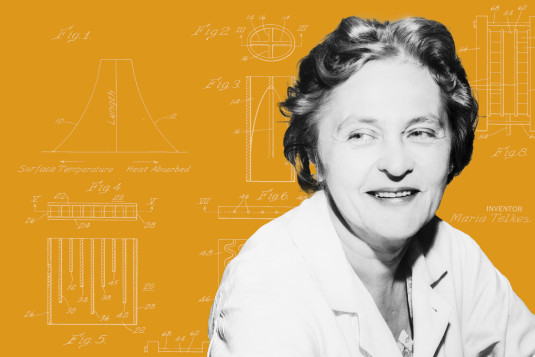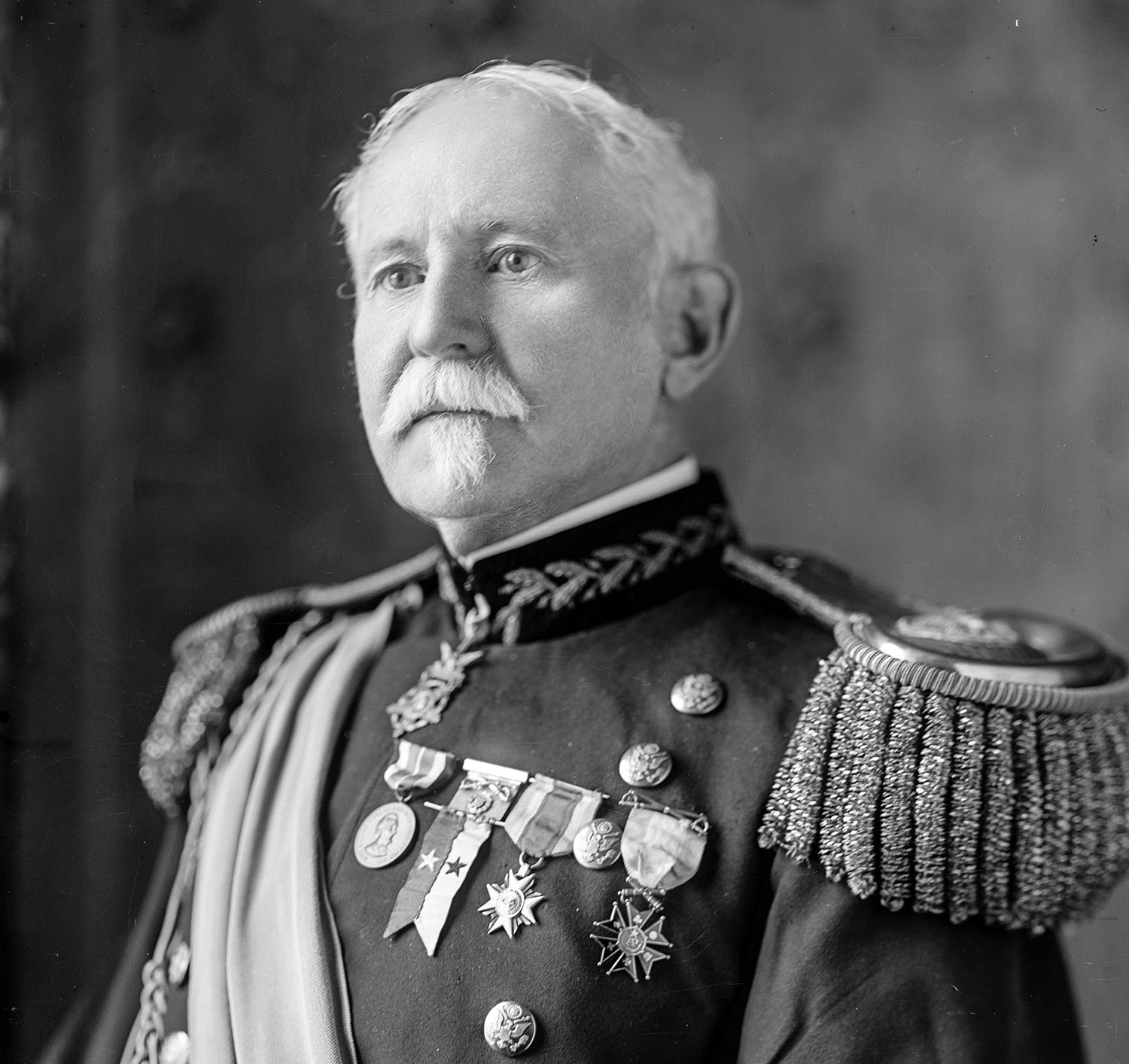
Uncommon design, uncommon valor
Forty years after his service as an engineer during the Civil War, George Gillespie redesigned the Medal of Honor, the nation’s highest military award, which he himself received. By obtaining a design patent, Gillespie ensured the integrity of the medal for future generations of U.S. service members.
16 min read
Each month, our Journeys of Innovation series tells the stories of inventors or entrepreneurs who have made a positive difference in the world. This month’s story focuses on George Gillespie, a Civil War veteran who redesigned and patented the Medal of Honor.
On May 31, 1864, George Gillespie Jr. escaped capture twice while he dashed through enemy lines under fire, carrying vital information from a commanding officer. This courageous act placed Gillespie in one of the most exclusive groups in American history: recipients of the Medal of Honor. Forty years after serving in the U.S. Army during the American Civil War, Gillespie led the effort to update the medal’s appearance. His design, which he patented in 1904, soon took center stage in a national conversation about the value and meaning of the medal, today this country’s highest honor for acts of valor in combat.
Gillespie was born in Kingston, Tennessee, on October 7, 1841, to George Lewis and Margaret Gillespie. Young George was one of at least four children, supported by his father’s earnings as a merchant and a farmer and his mother’s labor in the home. Little is known about Gillespie until he entered the U.S. Military Academy at West Point in 1858.
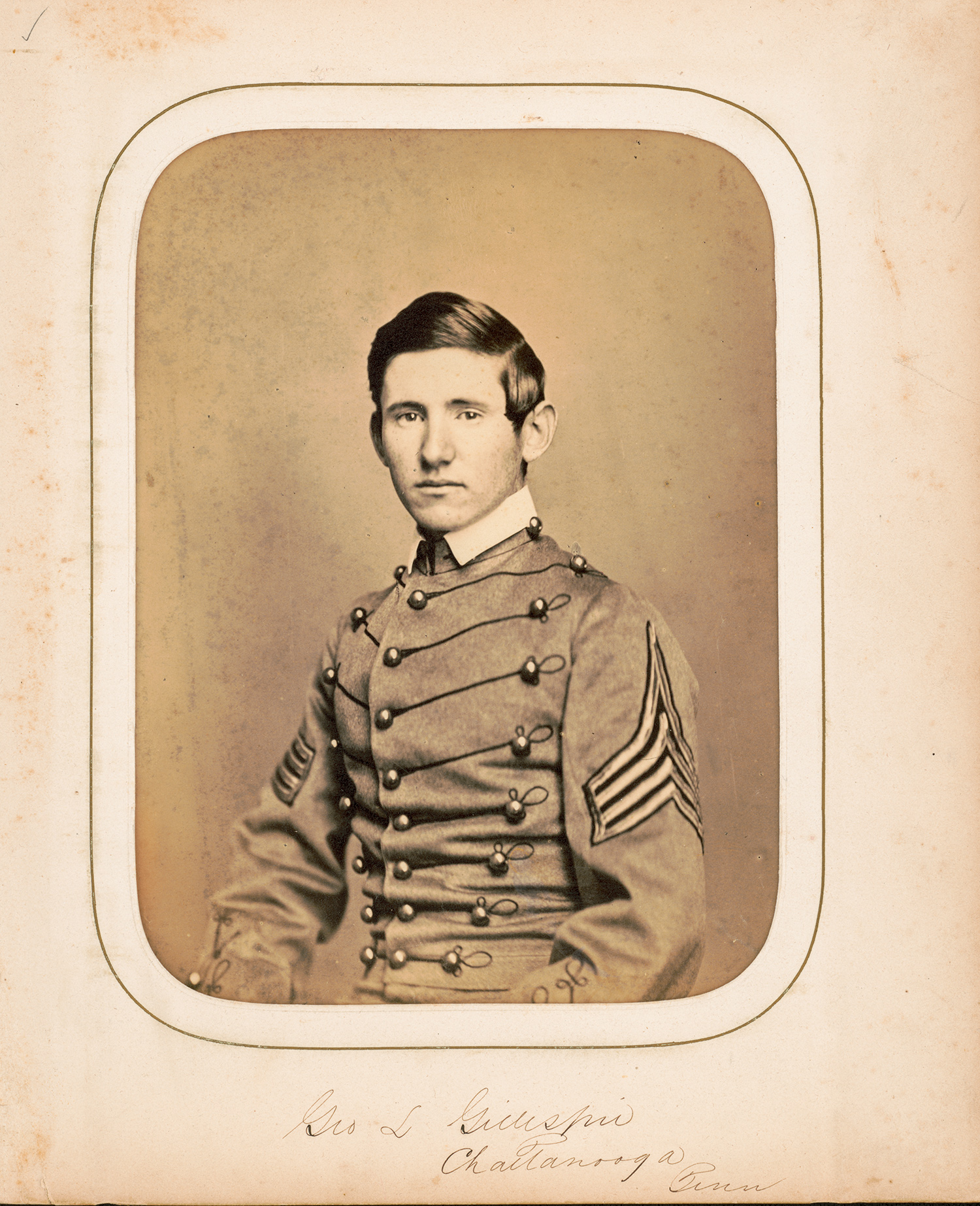
Gillespie began his military service at the age of 16 as a cadet at the U.S. Military Academy at West Point.
(Courtesy of the Library of Congress)
The Civil War broke out in Gillespie’s third year at the academy, with his home state of Tennessee seceding from the Union on June 8, 1861, the 11th and final state to join the rebellion. As many of his Southern classmates left West Point to fight for the Confederacy, Gillespie remained loyal to his oath and his nation, graduating second in his class in 1862 and receiving an assignment to the Army Corps of Engineers as a second lieutenant.
Gillespie’s long career as a soldier began during the deadliest war in American history, one that would ultimately claim more than 700,000 lives. During the Civil War, engineers conducted vital work such as constructing temporary roads and bridges for the armies, preparing accurate maps, and erecting the formidable defenses around Washington, D.C. Many of the men who enlisted as engineers also saw combat. In command of two companies of an engineer battalion with the Army of the Potomac, Gillespie first came under enemy fire while building pontoon bridges during the Battle of Fredericksburg in December of 1862. The following year, at Gettysburg, he was in charge of defending Major General George Gordon Meade’s base of operations. But it was during the Overland Campaign of 1864 that Gillespie would see his most intense action.
In May of 1864, after nearly a month of continuous combat moving south through Virginia, the opposing Union and Confederate armies circled each other on the outskirts of Richmond. Soldiers experienced sweltering heat and heavy skirmishing on May 31 in the beginning stages of what would soon be known as the Battle of Cold Harbor. Late in the day, Gillespie volunteered to cross through enemy lines to bring orders from Meade’s headquarters to General Philip Sheridan, the Union cavalry commander. The young West Point graduate, only 22 years old, came under fire from skirmishing Confederates, was captured, and managed to escape. He was again ordered to surrender by enemy troops and evaded a second capture by dashing away under fire, completing his mission.

Gillespie posed for this photograph in his general’s uniform in 1898. The Medal of Honor originally issued to him can be seen pinned to his uniform on the far right.
(Courtesy of the Library of Congress)
Having attained the rank of brevet lieutenant colonel by the end of the war, Gillespie then built a successful career with the U.S. Army Corps of Engineers, working on the growing nation’s burgeoning infrastructure. He lived in New Hampshire, Illinois, Oregon, New York, and Massachusetts, constructing fortifications and lighthouses and overseeing harbor work. Some of his most notable projects included the construction of the Tillamook Rock lighthouse off the coast of Oregon and the dredging of New York Harbor. Described by his fellow engineer W. R. Livermore as “tender and devoted to his family,” Gillespie brought his wife, Rhobie McMaster, and their two sons, Robert and Laurence, with him all over the country.
In 1897, Gillespie received his most significant accolade, a Medal of Honor for his actions during the Battle of Cold Harbor in 1864. The Army's Medal of Honor itself had been available since it was authorized by Congress during the Civil War for soldiers who “most distinguish themselves by their gallantry in action,” with many medals distributed during and shortly after the conflict. But a second wave of issuances occurred in the 1890s as the medal gained status and familiarity with veterans’ groups, and more frequent reunions encouraged former soldiers to share their stories from combat. In the decades following the Civil War, veterans like Gillespie increasingly saw the Medal of Honor as the most important of the many artifacts of a conflict receding farther and farther into history. Many aging veterans began nominating themselves and their comrades for the medal based on their actions during the war of their youth. Gillespie was among 500 or so recipients during this period. While it is unknown whether he was nominated for the medal or he nominated himself, his actions during the Civil War certainly qualified him for a Medal of Honor under the standards of the time.
To coordinate commemorative efforts, advocate for benefits, and elect candidates who supported their interests, hundreds of thousands of Civil War veterans also founded and joined patriotic and political organizations. These groups ranged from small local associations to national special interest groups such as the Medal of Honor Legion. The most influential of these organizations was the Grand Army of the Republic (GAR), a fraternal organization for Union veterans that maintained hundreds of local posts across the nation.
These organizations created badges and pins to identify their members at veterans’ reunions and ceremonial events, and many turned to existing symbols of valor for inspiration, even the Medal of Honor. Such copies of the official Medal of Honor aggravated its recipients, who worried that the official badge was now indistinguishable from badges produced by voluntary associations of veterans. So-called “Medal of Honor Men” decried the GAR’s medal in particular, an almost exact duplicate of the real thing. The proliferation of similar medals led to confusion, accusations of piracy, and pleas for change.
At the turn of the 20th century, Congress began an effort to protect the Medal of Honor’s exclusivity. Gillespie offered one voice in the chorus of calls for a redesigned and better protected Medal of Honor. But his voice was a powerful one.
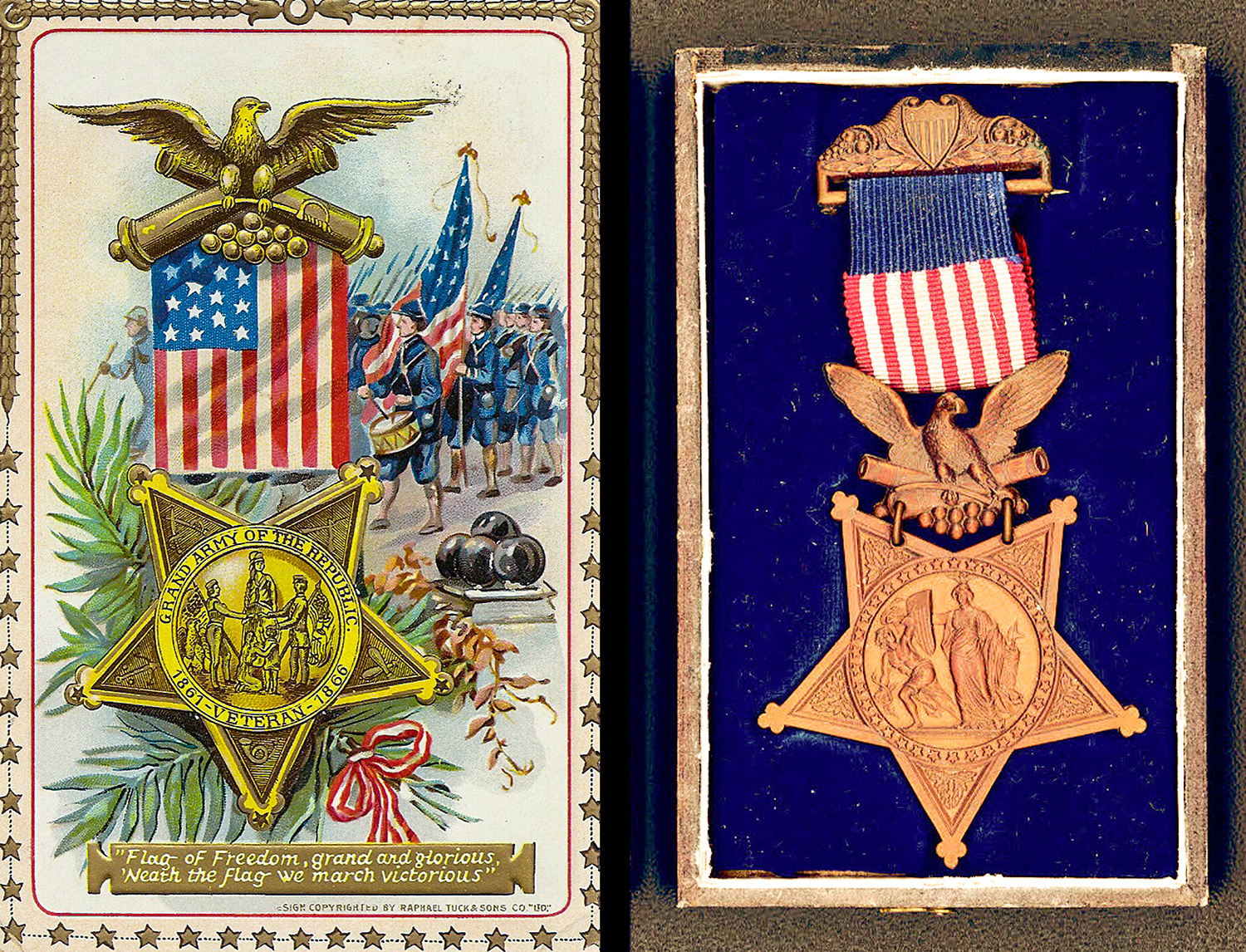
Left: Postcard depicting the GAR’s membership badge, 1915. Right: Medal of Honor issued to Captain Jeremiah Plumer, 1864.
(Left image courtesy of derrypubliclibrary, public domain, via Wikimedia Commons, while the right image is courtesy of the Library of Congress)
In many ways, Gillespie was an ideal choice to lead the effort to redesign the Medal of Honor. A belated recipient of the medal himself, Gillespie was still a career soldier. He served during wartime again in the 1898 Spanish-American War as commanding officer of the U.S. Army’s Department of the East and could therefore understand the interests of Medal of Honor recipients from America’s most recent conflicts. Moreover, his extensive experience as an engineer, culminating in his promotion to Chief of Engineers in 1901, gave him a keen eye for design and a penchant for solving problems. Finally, Gillespie was well respected and well connected but not in a leadership position in any of the current veterans’ groups.
Elihu Root, the Secretary of War from 1899 to 1904, tasked Gillespie with leading the effort to redesign the medal, with help from General Horace Porter, a fellow Civil War veteran and Medal of Honor recipient who was the U.S. Ambassador to France at the time. For around two years, Gillespie sought input from sculptors, the Medal of Honor Legion, and many recipients of the medal. He drafted and finalized a new design in early 1904 that was approved by Congress in April. To ensure that the new medal was not imitated or pirated by private groups, Gillespie chose to safeguard it with a design patent, an intellectual property protection for the ornamental design of an article of manufacture, where the novelty and value was in the appearance and not the function. Although designs were not originally eligible for protection in the United States, that changed in 1842, when the first design patent was granted to George Bruce of New York for a new typeface, and by the turn of the century, design patents were a well-established feature of the American intellectual property system.
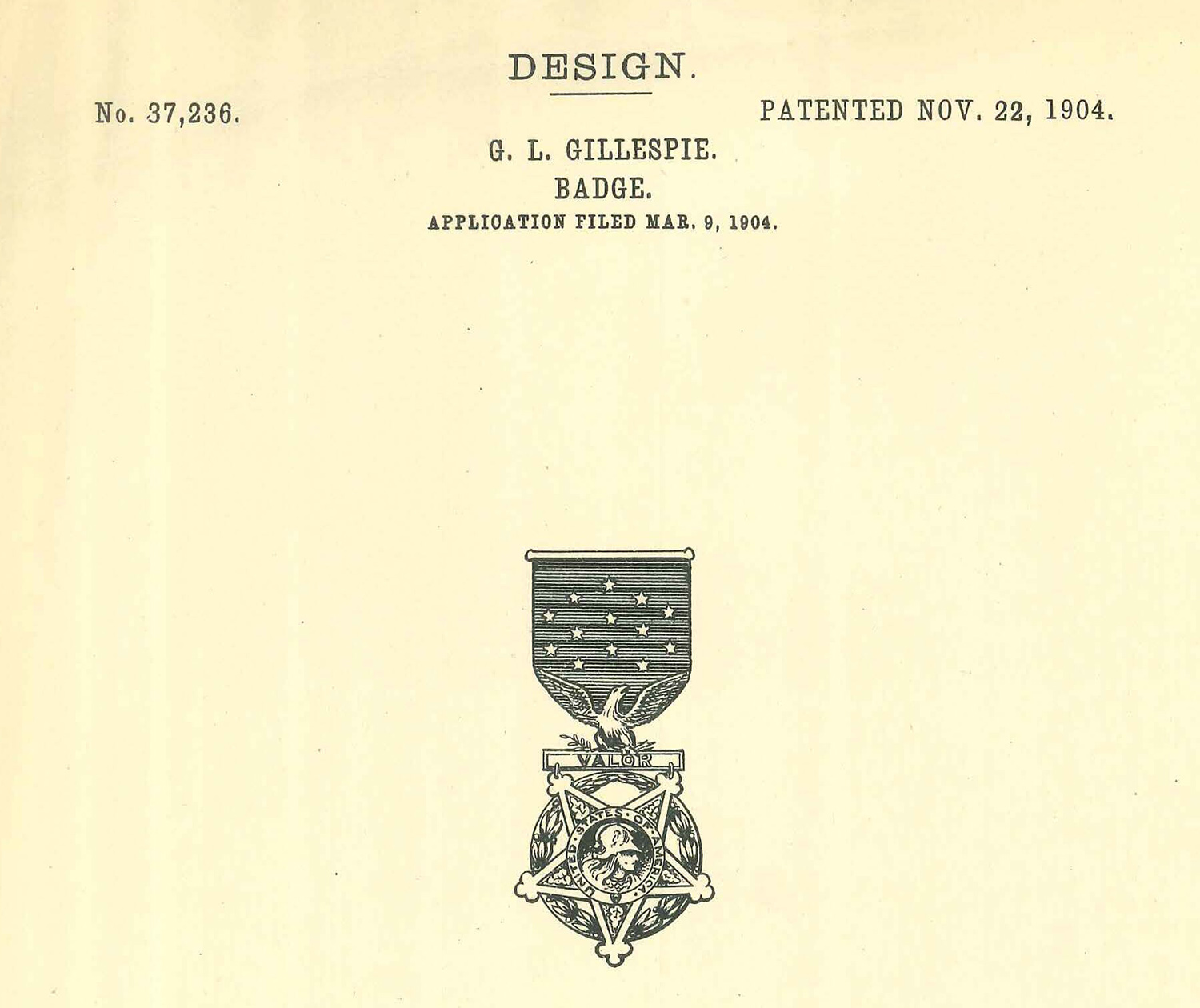
U.S. Design Patent No. 37,236, issued to G. L. Gillespie for a “badge.”
(Courtesy of the National Archives at Kansas City)
Gillespie submitted his patent application, simply titled “Design for a Badge,” on March 9, 1904. He included a rendering of the medal’s design and classified his “badge” as new, original, and ornamental. The brevity of his description belies the significance of this particular design—the words “Medal of Honor” appear nowhere in the application.
The U.S. Patent Office granted Gillespie U.S. Design Patent No. 37,236 on November 22, 1904. Shortly after, President Theodore Roosevelt, who himself would posthumously receive the Medal of Honor for his actions during the Spanish-American War, signed an executive order mandating that the medal must be presented at a formal ceremony.
Gillespie’s design borrowed some elements from the Civil War-era medal while incorporating several unique features. Retaining the shape of a five-pointed star, the new medal encircled it with a green wreath. Both medals featured the Roman goddess Minerva, but Gillespie’s design replaced a depiction of her crushing the secessionist South, a scene known as “Minerva repelling discord,” with the helmeted goddess in profile. The 1904 design also replaced the red, white, and blue striped ribbon with a ribbon of light blue, with 13 stars representing the 13 original states rather than 34 stars representing the size of the nation during the Civil War. The bar connecting the ribbon to the rest of the medal was inscribed with the word “Valor.” Gillespie’s medal was also to be worn as a pendant suspended from the lapel rather than pinned to the chest.
Soon after receiving his patent, Gillespie sought to transfer it to a caretaker who could enforce the offered protection and uphold the integrity of the medal in the future. Exactly who would act as this caretaker was a topic of keen interest to the veteran community and the press. Initial reports suggested that Gillespie intended to sign over his patent to the Medal of Honor Legion. In a letter to General Llewellyn G. Estes, the commander of the Legion, Gillespie wrote, “I have received from the commissioner of patents the paper securing to me patent rights for the new medal of honor. I think it best to turn this paper over to the legion in order that they may be a watchful body to protect the medal against copyists.” Despite these good intentions, many veterans grew concerned that this private organization, if granted ownership of the design patent, would also wield power over who received the honor. What impact these criticisms had on the eventual decision is uncertain, but Gillespie instead chose to transfer his patent back to the federal government. In December of 1904, he signed it over to William Howard Taft, then the Secretary of War. Taft and his successors would maintain the patent for the remainder of its 14-year lifetime.
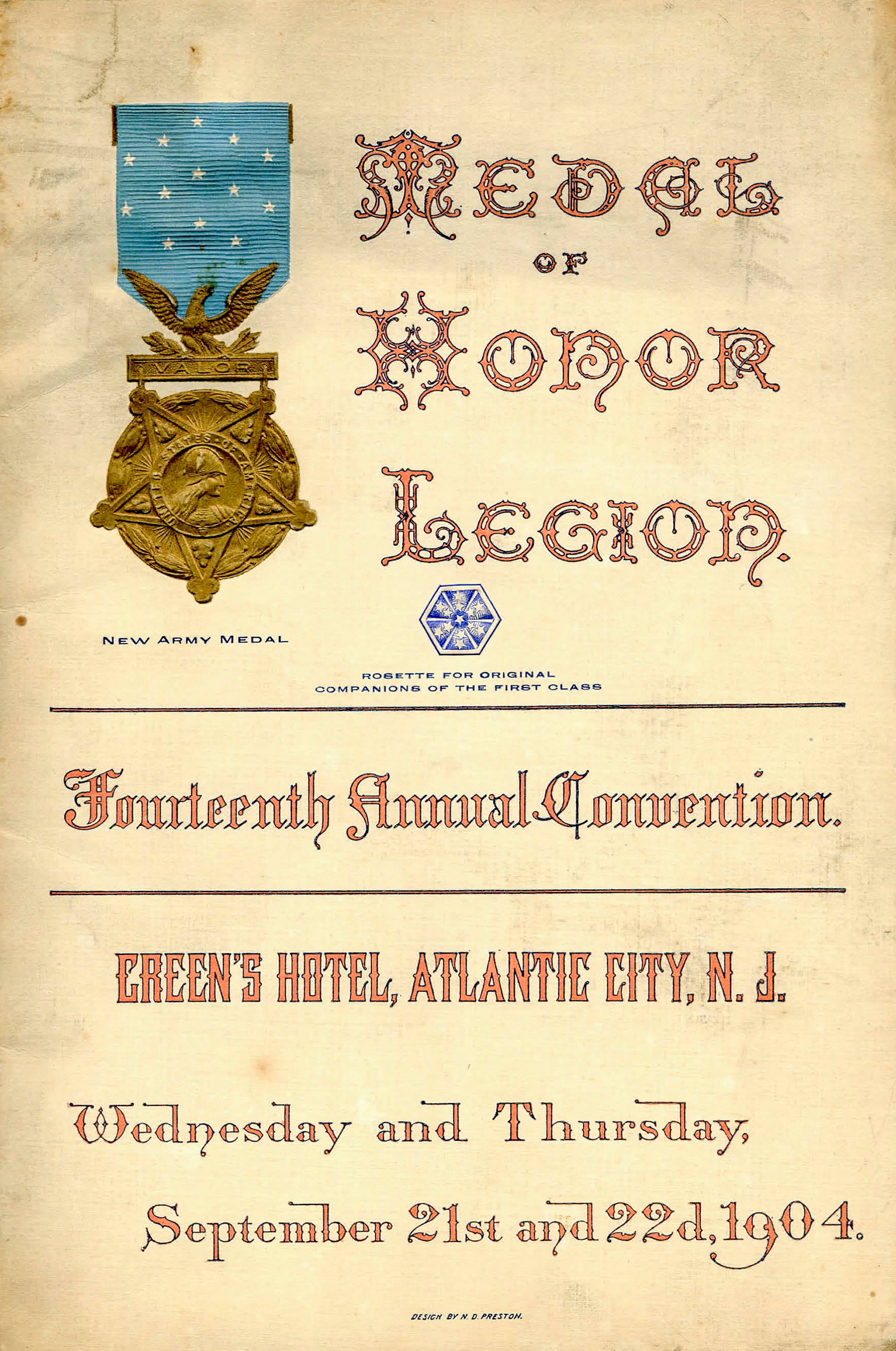
The title page for the booklet for the Medal of Honor Legion’s Annual Convention in 1904 depicted the new medal design.
(Courtesy of the University of Maine’s Digital Commons)
Powerful veterans’ groups also viewed the new medal design with scrutiny. The Medal of Honor Legion discussed it at their convention in September of 1904. Individually, veterans began writing to newspapers and speaking with reporters across the nation about it. Reactions to Gillespie’s design were largely positive. “It is generally agreed that the design is artistic and fitting, and in general appearance the medal is far better than the old one,” reported the New Haven Morning Journal and Courier in January 1905, two months after the patent was issued. “Gen. Gillespie is entitled to the credit of originating the new design, which was desired because there were many medals of private organizations which imitated the government medal of honor.”
Perhaps the most popular aspect of the new medal was the exclusivity afforded by the design patent. Journalist W. T. Manning reported that the change in design was welcomed, as “a number of organizations have so closely imitated the old medal that many persons who are wearing insignia of patriotic and political organizations were often treated as medal of honor men.” He went on to specifically tout the benefits of patent protection, stating that the new medal’s “one good feature” was that “its wearers are protected in that the medal is patented and infringements need not be dreaded in the future.”
Despite an overall favorable impression of the protection the patent afforded, reactions to Gillespie’s medal were not universally positive. Criticisms of the new medal largely centered around two main factors: the material composition of the medal itself and the requirement for previous Medal of Honor recipients to exchange their old medals for the new design.
Instead of being cast in one solid material, the new Medal of Honor was described in various newspapers as being made primarily of silver, brass, or “gun metal,” and plated with gold. Many veterans felt this mixed-metal composition lessened the intrinsic value of the piece. One scathing article printed in the Omaha Daily Bee proclaimed the new medal a “cheap bauble” with metal “tinseled over with the gilt and otherwise gewgawed with allegedly decorative enamel.” Many veterans said they would have preferred a medal made of solid iron or copper, contrasting the new design with comparable medals awarded in other countries, such as Germany’s Iron Cross and England’s Victoria Cross.
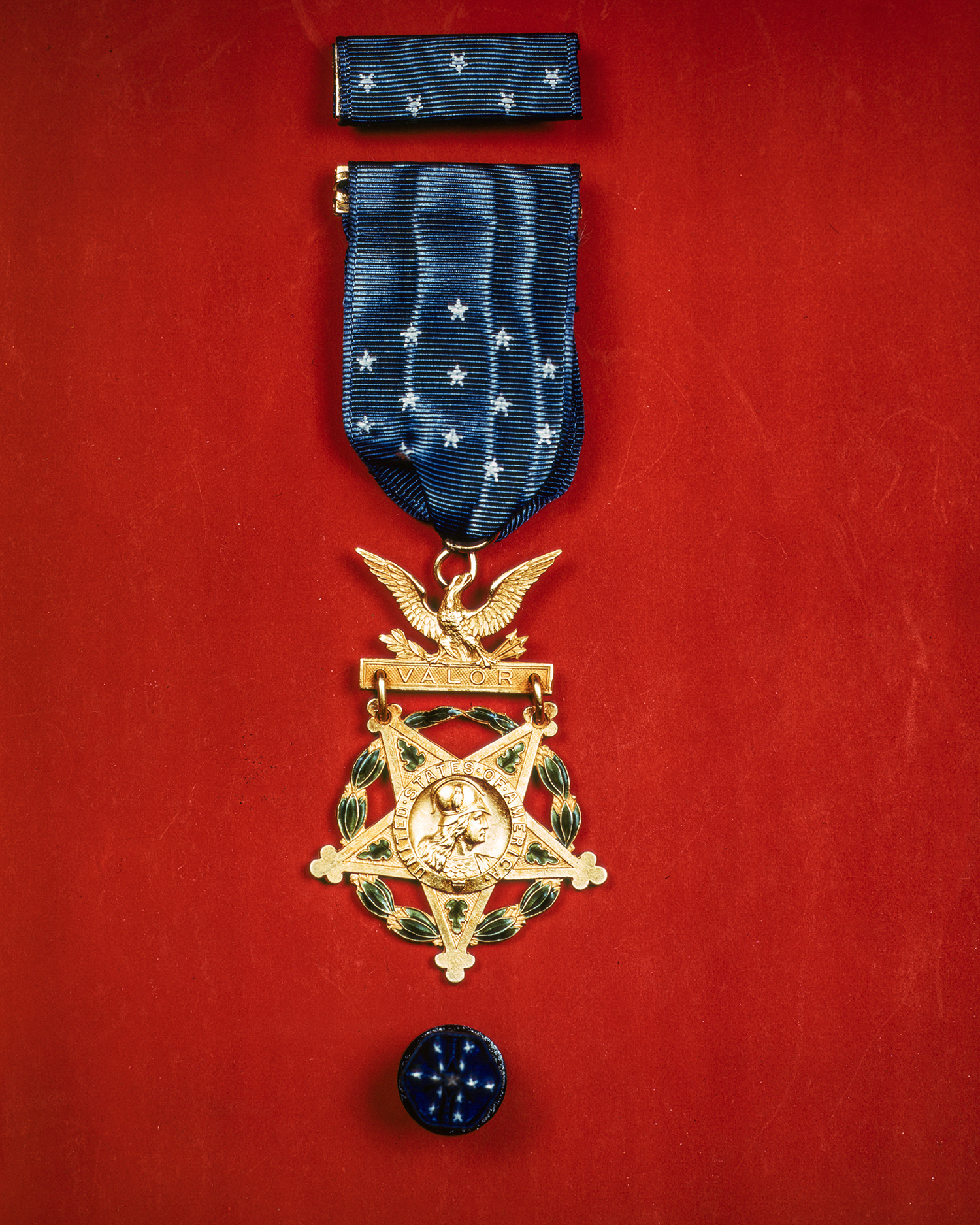
Known as the “Gillespie medal,” the 1904 design was adopted by Congress with the requirement that past recipients return their original medals.
(Courtesy of the Library of Congress)
Congress appropriated $12,000 for the manufacture and distribution of 3,000 medals in the new design, leading to another controversy among prior recipients who had strong sentimental attachments to the medals originally presented to them and did not wish to exchange them for the 1904 “Gillespie medal.” Anticipating resistance, the government required that the new medal be worn by recipients when in full-dress uniform. However, after extensive lobbying, Congressional representatives listened to the criticisms leveled by veterans and facilitated a compromise. In 1907, in a joint resolution, Congress authorized the return of the original medals to those recipients who had surrendered them, provided that “no recipient of both medals shall wear both medals at the same time.”
Despite numerous accolades for Gillespie’s design itself, some preferred the old over the new. B. D. Diggins, a Civil War naval veteran and Medal of Honor recipient, penned a letter to General Estes disparaging numerous aspects of the new design. The majority of Diggins’s criticisms centered around the new design’s movement away from imagery specific to the Civil War. He favored the old representation of Minerva, whose active pose, he claimed, “truly represents America driving out treason and discord.” More explicitly, he questioned the change to 13 stars in the new medal, preferring the previous 34 stars, “stars that many thought were reduced to twenty-one-stars … stars we helped to restore, the stars of 1861-1865.” Although many Civil War veterans, like Gillespie, recognized the need for a new design to protect the integrity of the medal in the future, some mourned the loss of a perceived connection to the past.
Diggins’s worries about the marginalization of the medal’s Civil War context were grounded in some reality. The redesign had indeed been part of a larger effort to modernize the Medal of Honor as the Civil War faded from memory. Veterans of later wars were already joining the ranks of Medal of Honor recipients and would one day outnumber and then supplant their Civil War counterparts in the community of living veterans.
When Gillespie’s original patent expired, Congress decided to use legislation to protect the design, enacting 18 U.S.C. § 704 in 1923, which prohibited the unauthorized wearing, manufacturing, or sale of military medals or decorations. As the criteria for receiving the medal changed over the course of the 20th century, Gillespie’s design stood the test of time. With the exception of a neck ribbon replacing the suspension ribbon in 1944, the U.S. Army has retained the vast majority of the Gillespie medal design. The Navy and Air Force have likewise stayed true to original designs. In all, more than 3,400 people serving in the military have received the Medal of Honor, the oldest continuously issued combat decoration in American history.
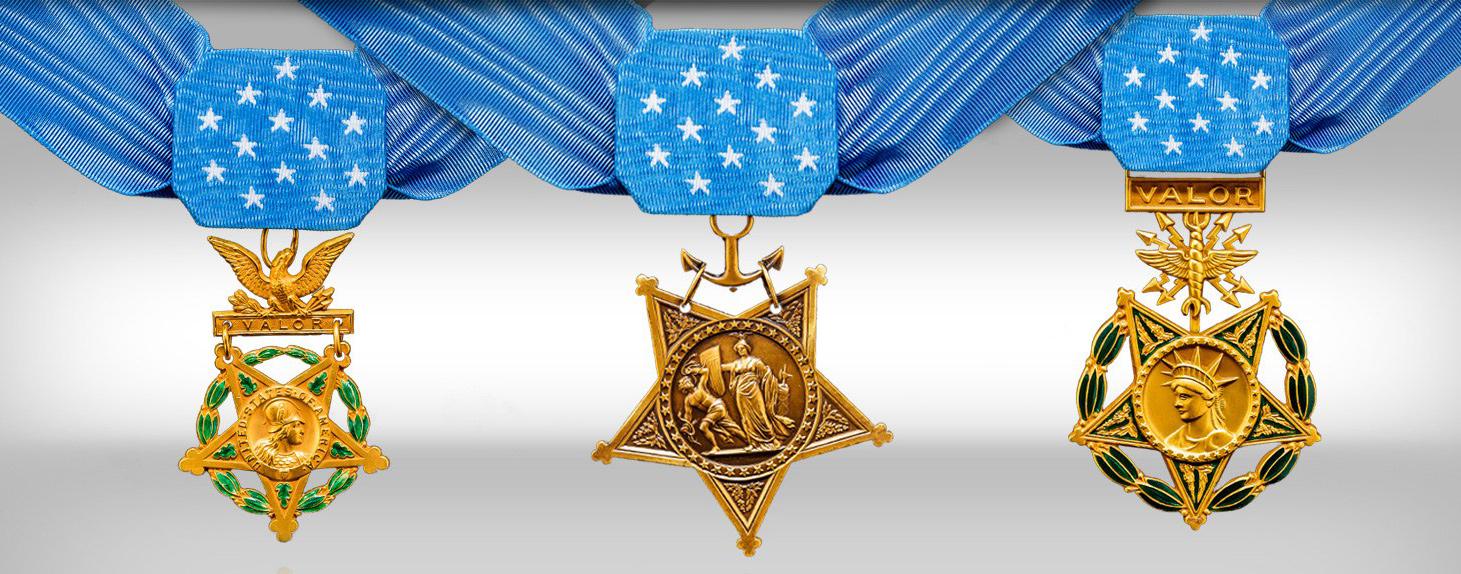
Modern Medal of Honor designs. From left to right: the Army, Navy, and Air Force.
(Courtesy of the U.S. Special Operations Command)
George Gillespie likely knew his efforts to redesign the Medal of Honor would be one of the last acts in his long, illustrious career as a soldier. He retired from active service on June 15, 1905, as the Assistant Chief of Staff of the U.S. Army at the rank of major general. Gillespie’s story in service is truly bookended by the Medal of Honor. He first earned recognition for risking his life for the life of his nation. Many years later, he relied on the protection of a patent to ensure the exclusivity of a design for an article of manufacture never meant for commercial production but holding incomparable value.
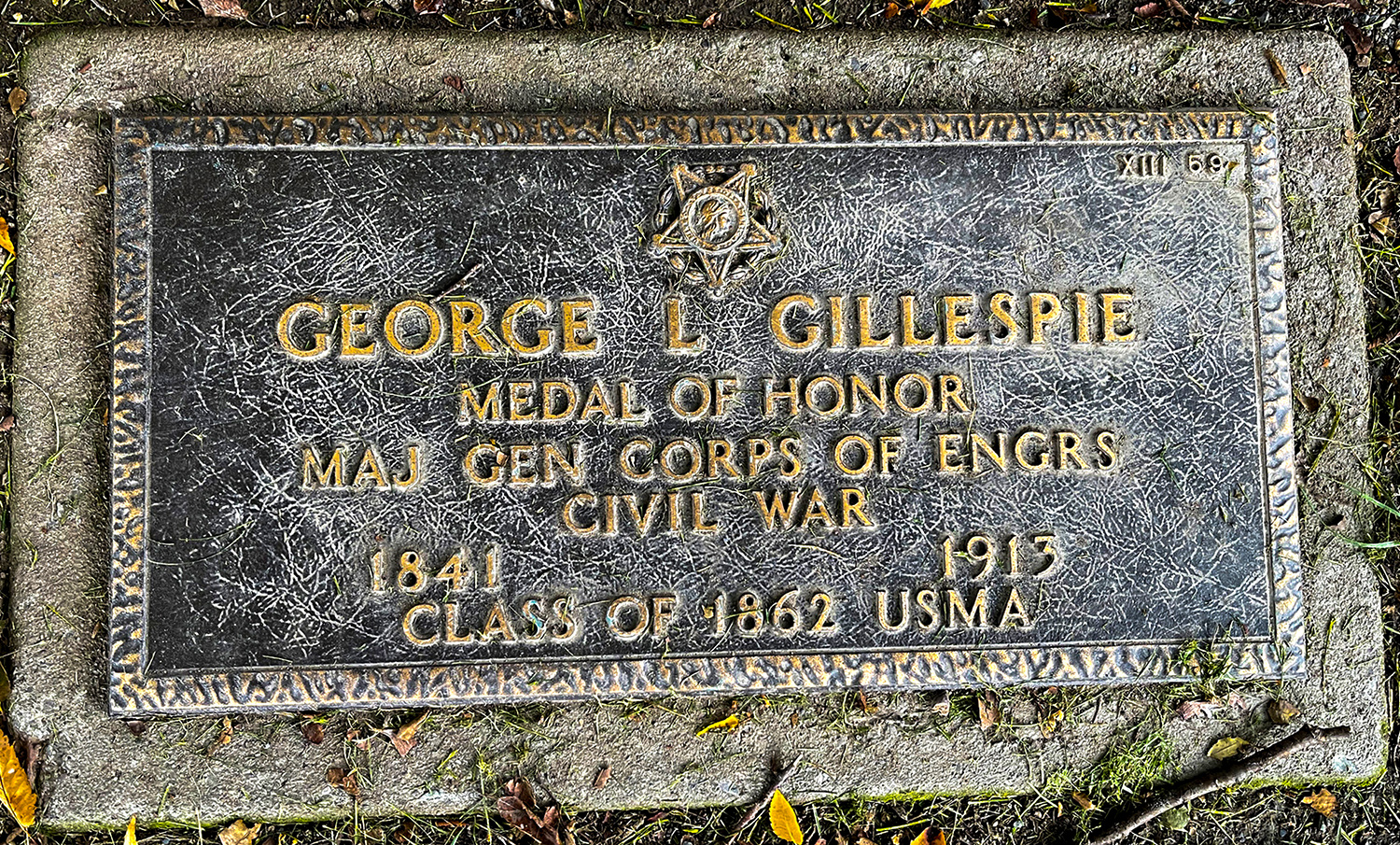
Gillespie’s grave marker at the West Point Cemetery. He is one of 18 Medal of Honor recipients interred at West Point.
(Photo courtesy of West Point Cemetery)
The majority of Medal of Honor recipients are not household names, but their stories contribute to a larger legacy of veterans and innovation. Gillespie and his fellow engineers adapted emerging technologies to the battlefield during the Civil War, preserving the Union and securing freedom for four million formerly enslaved people. He then helped build a post-war nation stretching from coast to coast during the first golden age of American innovation. Finally, Gillespie used the U.S. patent system to ensure the integrity of one of the nation’s most enduring national symbols. He is one of more than 11 million patent holders and more than two million Civil War veterans, more than 1,500 of whom received a Medal of Honor. Yet his story is entirely unique.
A fellow engineer described Gillespie as “cheerful in his manner and magnetic in his personality,” a person of “unswerving fidelity” to the nation. After a life of service, Gillespie died at his summer home in Saratoga, New York, on September 21, 1913, at the age of 72. He is interred in the West Point Cemetery, his grave emblazoned with the Medal of Honor design that bears his name.
Credits
Produced by the USPTO’s Office of the Chief Communications Officer. For feedback or questions, please contact inventorstories@uspto.gov.
Story by Rebekah Oakes. Contributions from Marie Ladino, Adam Bisno, and Eric Atkisson. The photograph of George Gillespie wearing the redesigned Medal of Honor at the beginning of this story is courtesy of the Library of Congress.
References
1850 United States Census, Kingston, Roane County, Tennessee, digital image s.v. “George L. Gillespie,“ Ancestry.com.
1860 United States Census, Kingston, Roane County, Tennessee, digital image s.v. “George L. Gillespie,“ Ancestry.com.
1870 United States Census, Buffalo, Erie County, New York, digital image s.v. “George L. Gillespie,“ Ancestry.com.
1880 United States Census, Portland, Multnomah County, Oregon, digital image s.v. “George L. Gillespie,“ Ancestry.com.
1900 United States Census, New York County, New York, digital image s.v. “George L. Gillespie,“ Ancestry.com.
1910 United States Census, Washington, D.C., digital image s.v. “George L. Gillespie,“ Ancestry.com.
“Army Gossip in Washington,” Omaha Daily Bee, December 20, 1904.
Baldwin, William, The U.S. Army Corps of Engineers: A History (Alexandria, VA: U.S. Army Corps of Engineers, 2008).
Hearings, Reports, and Prints of the Senate Committee on Veterans’ Affairs (Washington, DC: U.S. Government Printing Office, 1979).
Livermore, W. R., "George L. Gillespie," Professional Memoirs, Corps of Engineers, United States Army 9, no. 47 (September-October 1917).
“Major Gillespie’s Medal of Honor is Adopted,” Topeka State Journal, December 28, 1904.
Manning, W. T., “Men Object to the New Medal of Honor: Claim is Made That it is Too Conspicuous,” Age-Herald, January 10, 1903.
Mears, Dwight S, The Medal of Honor: The Evolution of America’s Highest Military Decoration (University of Kansas Press, 2018).
"Medal of Honor, 1863-1968," report prepared for the Subcommittee on Veterans' Affairs of the Committee on Labor and Public Welfare, U.S. Senate (Washington, DC: U.S. Government Printing Office, 1968).
“Medal of Honor Fight Bitter,” New-York Daily Tribune, December 28, 1904.
“Medal of Honor History,” National Cemetery Administration, www.cem.va.gov/history/Medal_of_Honor_History.aspwww.cem.va.gov/history/Medal_of_Honor_History.asp (accessed September 12, 2021).
“Medal of Honor Legion Fourteenth Annual Convention Booklet” (1904), Paul W. Bean Civil War Papers, item 46, digitalcommons.library.umaine.edu/paul_bean_papers/46.
“Medal of Honor Legion Meets at Convention,” Las Vegas Daily Optic, September 22, 1904.
Mollan, Mark C., “The Army Medal of Honor: The First Fifty-five Years,” Genealogy Notes 33, no. 2 (Summer 2001).
“New Medal of Honor: Vigorous Protest Against the War Department Circular,” Evening Star (Washington, D.C.), January 5, 1905.
“Obituary for George L. Gillespie,” Dayton Daily News, September 21, 1913.
“Patent Right Transferred,” Evening Star (Washington, D.C.), December 3, 1904.
“Protests Too Late: New Medal of Honor Will Supplant the Old,” Evening Star (Washington, D.C.), December 26, 1904.
Rhea, Gordon C., Cold Harbor: Grant and Lee, May 26-June 3, 1864 (Baton Rouge: Louisiana State University Press, 2002).
“The New Medal of Honor: And Why It is Less Liked Than the Old One,” New Haven Morning Journal and Courier, January 2, 1905.



